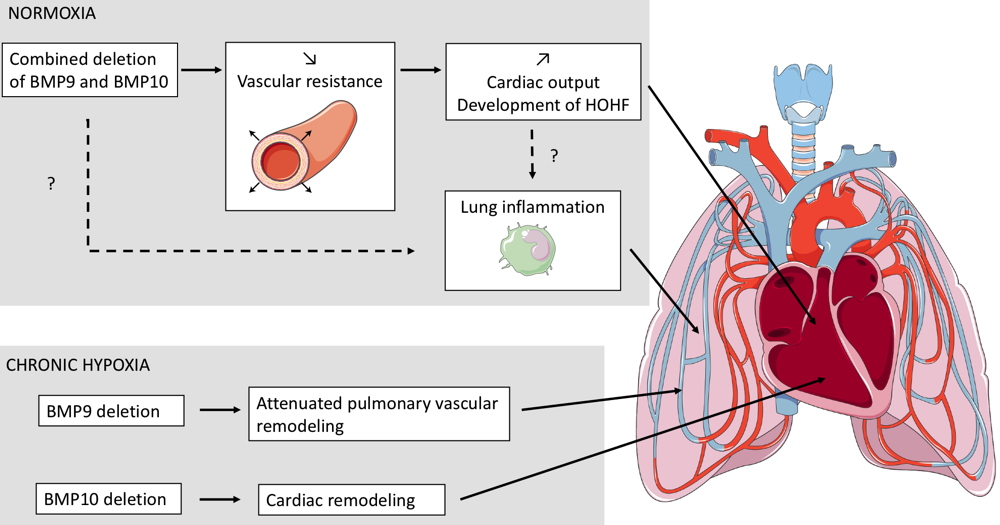BMP9 and BMP10 are circulating factors that share a high degree of sequence identity (64% in the mature domain). They bind to ALK1 and BMPR2 receptors, which are present at the surface of endothelial cells and activate the SMAD pathway. Mutations in this signaling pathway are associated with two rare vascular diseases, pulmonary arterial hypertension (PAH) and hereditary hemorrhagic telangiectasia (HHT).
BMP9 and
BMP10 mutations were recently identified in patients with PAH, and
BMP9 mutations in patients with HHT-like symptoms. However, their specific roles in the pathogenesis of these diseases are unclear. We decided to study and compare the roles of BMP9 and BMP10
in vivo in adult mice using single and double knockout (KO) models.
Bmp9 is deleted constitutively and
Bmp10 is deleted once the mice are adult (to bypass embryonic lethality)
[1].
We first studied the phenotypes of these mice in normal conditions (unchallenged). The single-KO mice did not develop any obvious phenotype. However, the double deletion of
Bmp9 and
Bmp10 led to a reduction of peripheral resistance, vasodilation and progressive development of high output heart failure and signs of inflammation and bleeding in the lungs. We detected abnormal connections between arteries and veins (shunts or capillary dilation), which is a feature of HHT.
We previously found that mice lacking
Bmp9 were protected against pulmonary arterial remodeling in PAH models
[2], and we wanted to know if it would also be the case for
Bmp10. For this purpose we used a hypoxia-induced pulmonary hypertension model and we found that only
Bmp9-KO mice but not
Bmp10-KO mice were protected. On the other hand,
Bmp10 deletion in hypoxia led to cardiac remodeling.
These results show that although BMP9 and BMP10 activate the same pathway they can play different roles
in vivo, and that these two factors plays key specific roles in cardiac and lung homeostasis.

Collaborations:
Christophe Guignabert, Ly Tu, Marc Humbert, Laurent Savale UMRS_999 hypertension pulmonaire, Physiopathologie et nouvelles thérapies, Le Plessis Robinson
Pascale Perret, Inserm UMRS_1039, Laboratoire de radiopharmaceutiques biocliniques, Grenoble
Thomas Daubon, Andreas Bikfalvi Inserm UMRS_1029, angiogenèse et microenvironnement tumoral, Pessac